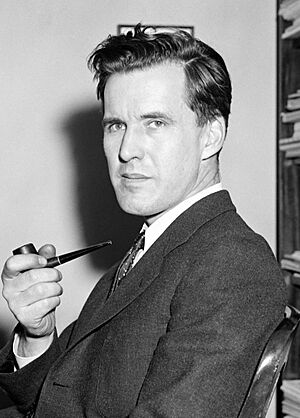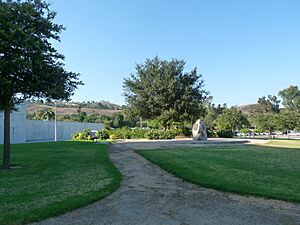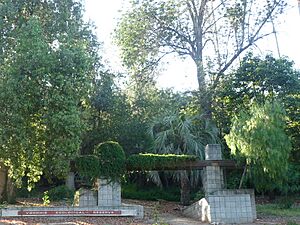Jerry Voorhis facts for kids
Quick facts for kids
Jerry Voorhis
|
|
|---|---|
 |
|
| Member of the U.S. House of Representatives from California's 12th district |
|
| In office January 3, 1937 – January 3, 1947 |
|
| Preceded by | John H. Hoeppel |
| Succeeded by | Richard Nixon |
| Personal details | |
| Born |
Horace Jeremiah Voorhis
April 6, 1901 Ottawa, Kansas, U.S. |
| Died | September 11, 1984 (aged 83) Claremont, California, U.S. |
| Political party | Democratic (from 1934) Socialist (until 1934) |
| Spouse |
Alice Louise Livingston
(m. 1924) |
| Alma mater |
|
| Signature |  |
Horace Jeremiah "Jerry" Voorhis (born April 6, 1901 – died September 11, 1984) was an American politician and teacher. He was a member of the Democratic Party. Jerry Voorhis served five terms in the United States House of Representatives. This means he was a lawmaker for 10 years, from 1937 to 1947. He represented the 12th congressional district in Los Angeles County, California. He is also known for being the first political opponent of Richard M. Nixon. Nixon defeated Voorhis in a tough election in 1946. This campaign is often mentioned as an example of Nixon's use of "red-baiting." This means accusing someone of being a communist or having communist sympathies.
Voorhis was born in Kansas, but his family moved around a lot when he was a kid. He went to Yale University and later earned a master's degree in education. In 1928, he started the Voorhis School for Boys. He was the headmaster of this school even while he was in Congress. In the House of Representatives, Voorhis strongly supported the "New Deal." This was a series of programs and reforms by President Franklin D. Roosevelt. Voorhis was known for his liberal views, meaning he supported social change and government action to help people. His most important law was the Voorhis Act of 1940. This law made certain groups controlled by foreign powers register with the government. After winning re-election four times, he faced Richard Nixon in 1946. Nixon made Voorhis's supposed support from groups linked to the Communist Party a big issue. Nixon won the election, and Voorhis decided not to run against him again in 1948. After leaving politics, Voorhis worked for many years in the cooperative movement. He wrote several books during his life. He passed away in 1984 at the age of 83.
Contents
Early Life and Education
Jerry Voorhis was born in Ottawa, Kansas, on April 6, 1901. His father, Charles Brown Voorhis, was of Dutch descent. His mother was Ella Ward (Smith) Voorhis. Jerry's grandfather, Aurelius Lyman Voorhis, was a merchant and lawyer. Jerry's father, Charles, became an executive at car companies like Oakland Motor Car Company (which became Pontiac) and Nash Motor Company.
Jerry Voorhis went to school in several cities as his family moved. He attended the Hotchkiss School, a boarding school in Connecticut. Then he went to Yale University, graduating in 1923. At Yale, he was chosen for the Phi Beta Kappa honor society. He was also president of the Christian Association. He was very influenced by the Social Gospel movement. This movement believed that Christian teachings should be used to solve social problems.
After college, Voorhis wanted to help people, not just work in business. He worked as a receiving clerk and freight handler for a short time. In 1923 and 1924, he worked for the YMCA in Germany. He had to return home due to illness.
Starting a Family and a School
After recovering, Jerry Voorhis joined his parents in Kenosha, Wisconsin. There, he met Alice Louise Livingston, a social worker. They got married on November 27, 1924. After getting married, Voorhis worked at a Ford plant in Charlotte, North Carolina. Later, he became a teacher at a school for underprivileged boys in Illinois. He taught three grades and coached sports. After that, he and his wife started an orphanage for boys in Laramie, Wyoming.

In 1927, Jerry's father, Charles Voorhis, offered him a chance to start a boys' academy. It would be near his father's home in Pasadena, California. So, Jerry Voorhis moved to California. In 1928, he founded the Voorhis School for Boys in San Dimas, California. He was the headmaster of the school even after he was elected to Congress. The school taught academic subjects and practical skills like farming and mechanical work. The Voorhis family put a lot of their money into the school.
When Voorhis was elected to Congress, the school closed. The land and buildings were given to California State Polytechnic University, Pomona (Cal Poly Pomona). This became the university's campus for a while. Voorhis stayed in touch with the students who had attended his school.
Voorhis also got involved in his local community. He helped local farmers and ranchers form cooperatives. These are groups where people work together for shared benefits. He also supported workers during strikes. From 1930 to 1935, Voorhis gave lectures at Pomona College. He also started writing articles. In 1933, he wrote about how society could produce enough for everyone. He believed this would happen if wealth was owned by the public.
Political Career
Serving in Congress
In 1934, Voorhis ran for the California State Assembly. He changed his political party from Socialist to Democrat. However, he lost that election. Two years later, he ran for Congress in the 12th district. He challenged the current lawmaker, John Hoeppel. Hoeppel was in trouble because he had been caught trying to sell a nomination to West Point. Voorhis won the Democratic nomination. He ran as a "Progressive Roosevelt-Democrat." He easily defeated the Republican candidate in the general election.
Voorhis was reelected to Congress four times. He had a very liberal voting record. He supported President Franklin D. Roosevelt's "New Deal" programs. He even supported Roosevelt's plan to change the Supreme Court.
In 1937, Voorhis suggested increasing spending for the Works Progress Administration (WPA). The WPA was a program that created jobs during the Great Depression. His idea was to help more people find work. Although his first attempt didn't pass, Congress later increased WPA spending. Voorhis became a leader among the progressive lawmakers in Congress. He wanted the government to buy the stock in the Federal Reserve Banks. This would help pay for government expenses. He also worked with Congressman Wright Patman. They made sure that Federal Reserve Banks paid most of their earnings from government bonds back to the U.S. Government.
Before World War II, Voorhis wanted the U.S. to stay neutral. He suggested a law that would require a national vote before going to war. He believed that banning arms sales and loans to other countries would keep the U.S. out of war. However, once the war began, Voorhis supported it. He also supported the internment of Japanese-Americans. This meant moving them to special camps during the war. But he wanted it done as kindly as possible. He also wanted officials to manage their property. During the war, Voorhis pushed for higher taxes on rich people and war profits. He also wanted plans for jobs after the war.
Voorhis often disagreed with the oil industry. He questioned why oil companies got special tax breaks. In 1943, he learned that the Navy Department planned to give Standard Oil free drilling rights. This was for a huge oil reserve in California called Elk Hills. Voorhis spoke out against this deal in Congress. The deal was soon canceled. The Washington Post newspaper praised him as a hero. However, the Los Angeles Times said he hurt the war effort. In 1945, Voorhis fought against a bill that would give oil companies offshore drilling rights. He won, and the bill was defeated. Some people believe that oil companies secretly helped Richard Nixon financially in the 1946 election because of Voorhis's actions.
Voorhis's Congressional Work
Voorhis strongly disliked communism. He sponsored the Voorhis Act of 1940. This law required political groups controlled by foreign powers to register with the Justice Department. Voorhis also served on the House Un-American Activities Committee (HUAC). This committee investigated people suspected of being disloyal to the U.S.
Voorhis was generally well-liked by his fellow lawmakers in Washington. Senator Paul Douglas called Voorhis "a political saint." He said Voorhis felt he had to learn everything about every topic in Congress. Then he would speak his mind. Voorhis often gave short speeches in the House of Representatives. He spoke on many topics, from local issues to international money matters. The press called him "Kid Atlas" because he seemed to carry the weight of the world. Reporters also voted him the most honest congressman.
Voorhis's district usually voted Republican. In 1941, there was an attempt to change the district's borders. This was done to make it harder for Voorhis to win. But he still won re-election by about 13,000 votes in 1942 and 1944. Before 1946, Voorhis had not faced very strong opponents. He was elected in 1936 during President Roosevelt's big win. In 1938, his opponent was so shy that Voorhis had to introduce him at a public event. In 1944, the Republicans in his district were divided, so Voorhis won easily.
Voorhis was a very dedicated congressman to the people he represented. He remembered important events like births and anniversaries. For example, when Richard Nixon's daughter, Tricia, was born in 1946, Voorhis's office sent the Nixon family a government book called Infant Care.
Voorhis didn't pass many new laws, except for the act named after him. Nixon used this against him in 1946. Nixon said Voorhis's only law had just "transferred jurisdiction over the raising of rabbits from one government department to another." The New York Times wrote in 1947 that Voorhis was "ineffectual in terms of practical results."
The 1946 Election
As Voorhis was serving his fifth term, local Republicans looked for someone to beat him. Richard Nixon decided to run. Nixon was still in the Navy when he was asked to run. He wrote that Voorhis's "conservative" reputation needed to be "blasted." Nixon wanted to give positive speeches about what he planned to do. At first, some Republicans thought Nixon's campaign had no chance.
In California at that time, candidates could run in both parties' primary elections. This was called "cross-filing." Voorhis had done this for a long time. Winning both primaries almost guaranteed election. Both Nixon and Voorhis won their own party's primary. Voorhis got many votes in the Republican primary. He had 7,000 more votes than Nixon overall. However, newspapers pointed out that Voorhis's total percentage of the vote had dropped. This gave Nixon momentum.
Voorhis had the advantage of being the current lawmaker. But Nixon had other advantages. Voorhis could only spend two months campaigning because of his work in Congress. Nixon campaigned for ten months. Voorhis's time was even more limited when he had surgery in August 1946. He spent two weeks recovering in a hotel.
Nixon claimed that voting against Voorhis was "a vote against the P.A.C." He linked the P.A.C. (Political Action Committee) to the Congress of Industrial Organizations (CIO). Nixon said the CIO had "Communist principles." Nixon's campaign gave out 25,000 thimbles that said "Nixon for Congress/Put the needle in the P.A.C."
A big issue in the campaign was Voorhis's supposed connection to the CIO-PAC. Many believed this group was a Communist front. Nixon's campaign manager said he had proof. On September 13, the two candidates debated at South Pasadena Junior High School. When Nixon was asked for proof, he pulled out a bulletin from the National Citizens Political Action Committee. This bulletin endorsed Voorhis. Voorhis's staff knew about the endorsement, but Voorhis himself did not. Voorhis pointed out that these were two different groups. Nixon replied by reading the names of the board members of both groups. Many names were the same. After the debate, Voorhis asked Congressman Chester E. Holifield how he thought it went. Holifield said, "Jerry, he cut you to pieces." Voorhis had been successfully linked with "the PAC." He had actually refused to accept support from any PAC unless it rejected Communist influence. Nixon defeated Voorhis by over 15,000 votes. Time magazine praised Nixon for "politely avoid[ing] personal attacks."
The day after the election, Voorhis accepted his defeat. He said, "I have given the best years of my life to serving this district in Congress. By the will of the people, that work is ended. I have no regrets about the record I have written." In his 1947 book, Confessions of a Congressman, Voorhis blamed his loss on the huge amounts of money Nixon's campaign supposedly spent. Nixon later joked, "What I am wondering is where all the money went that we were supposed to have had!"
Nixon's win over Voorhis is seen by some as the start of his "red-baiting" campaigns. These campaigns later helped him become a Senator and Vice President. Voorhis later called himself "the first victim of the Nixon-Chotiner formula for political success." In 1958, Voorhis claimed that voters received anonymous phone calls saying he was a Communist. He also said newspapers called him a "fellow traveler," meaning someone who secretly supports communism.
Despite any hard feelings, Voorhis sent Nixon a letter of congratulations. The two men met and, according to Voorhis, parted as friends. Voorhis's last letter as a congressman was to his father. He thanked his father for his help and advice throughout his political career.
Later Life and Legacy
After leaving Congress, Voorhis stayed in his home in Alexandria, Virginia. He finished writing his book, Confessions of a Congressman. In 1947, he was offered a job as executive director of the Cooperative League of the USA. This organization worked with different types of cooperatives. The Voorhis family moved to Winnetka, Illinois. Under his leadership, the League's finances improved. More cooperatives joined the organization. The League also started new groups, like the Group Health Association of America.
Voorhis was asked to run against Nixon again in 1948. He declined, partly for health reasons. Nixon ended up winning both the Republican and Democratic primary elections that year. This meant he had no opponent in the general election.
In 1954, Voorhis led the U.S. group to the International Cooperative Alliance meeting in Paris. He successfully stopped Soviet plans to give more power to Eastern European countries. This was seen as a way for communists to gain control of the organization. Voorhis sometimes spoke before Congress. He usually spoke against bills that would tax cooperatives. He also helped form cooperatives in Latin America. In 1963, the first conference of cooperatives for the entire Western Hemisphere took place in Montevideo, Uruguay. Voorhis retired from the League in 1967.
Five days after Nixon lost the 1962 California governor's election, Voorhis appeared on TV. He spoke about how Nixon had acted in the 1946 election. Voorhis later wrote another book, The Strange Case of Richard Milhous Nixon. In it, he said Nixon was a "ruthless opponent." He believed Nixon's main rule was "to win, whatever it takes to do it."
As Nixon's presidency faced problems, Voorhis spoke out more. In 1972, he said, "Sour grapes to criticize the man who beat me, but I just wouldn't be human if I said I liked spending the second half of my life as 'the man who Nixon beat'." After Nixon resigned as President, Voorhis noted that Nixon's "doing-anything-to-win" philosophy had received its "just and proper reward." Voorhis felt that Nixon had labeled him a subversive. He took some satisfaction in saying that Nixon himself had been subversive. Voorhis believed Nixon tried to create a "virtual dictatorship" in the country.
In 1972, Voorhis and his wife moved into a retirement home in Claremont. He continued to work on committees and advisory boards. He was on the California Commission on Aging. He also worked as a teacher's aide. Jerry Voorhis died at the retirement home on September 11, 1984, from emphysema. He left behind his wife, two sons, and a daughter. Former California governor Pat Brown said, "He was a great man. Not many like him these days." Voorhis is buried in Mountain View Cemetery in Altadena, California. His papers are kept at The Claremont Colleges Library.
An elementary school in El Monte, California, is named after Jerry Voorhis. Cal Poly Pomona considers Voorhis one of its founders. They have named a park and an ecological reserve after him.
See also
- List of members of the House Un-American Activities Committee





